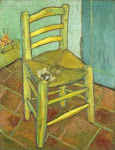
A week ago, the evening of November 7th, a Van Gogh painting failed to sell ("Fields," July 1890). The biggest Impressionist/Modern Art sale of the Sotheby's season, and the very publicized Van Gogh did not sell. The auctioneer, while coolly professional, looked surprised and a little perturbed, and when he made the last call for bidding ("Fair warning..."), I think there were crickets in the back of the room. No, I wasn't there; I watched it as live webcast on Sothebys.com. The painting didn't make its reserve ($25 million) so it passed, and because Sotheby's put a guarantee on it with the seller, they now own it. And have to figure out what to do next.
Surprising was the reaction next day. Sotheby's stock plunged about 28%--and the analysts talked about the "Van Gogh Factor." If the Van Gogh can't sell, the art market must be in terrible trouble! Or so the media outlets said. Others grumbled that the estimate was too high, that this painting had been quietly shopped around for months, etc.
What gets me is the irony. During Van Gogh's lifetime, for him not to sell a painting was hardly world news. "He only sold one painting" has become one of those things people just know about Van Gogh. Stocks didn't fall, newspapers didn't notice, and auction houses' bank accounts didn't hinge on the sale or non-sale of a Van Gogh. So what would Vincent make of last week's auction and the response? Would he laugh at the irony or be perplexed that one of his paintings would carry a $28-35 million dollar estimate to begin with? What would he say if he knew he had the power to influence Wall Street?






No comments:
Post a Comment